Since the earliest days of American domestic life, the farmhouse kitchen cabinet has been the quiet, sturdy heart of the home. It wasn’t born from a design movement; it was born of necessity—a practical response to daily life that prioritized solid function over decoration. That heritage has evolved, making it an emblem of honest tradition in today’s homes. The most thoughtful and enduring kitchens I’ve seen understand this duality: beauty must grow directly from utility. The twenty principles that separate truly authentic farmhouse kitchen cabinets from a passing trend haven’t changed in centuries. They are about getting to the very soul of the design.
In my work as a specialist in historic home renovation, I’ve come to see the real pull of these kitchens. It isn’t just about a “look.” It’s about a feeling—a connection to the architectural bones of the house. These cabinets are, in a way, living history, with every joint and finish whispering something about craftsmanship and resilience. To do them right, you have to do more than just copy a style. You have to understand where they came from and honor that story.
This guide will walk you through my process, moving from the foundational philosophy of farmhouse design to the hands-on realities of material and construction. We’ll start with the essential principles that define the aesthetic. Then, we’ll get into the woods, the finishes, and the hardware that give them their character. After that, we’ll look at how to fit them into your space for modern living, and finally, how to ensure they’re built not just for you, but for the generations that will follow. Think of this as a journey into crafting not just cabinetry, but a future heirloom.
Ancestral Resonance and Authentic Imperatives (Part 1)
Before you pick a single paint chip or door style, you have to understand the philosophy. Authentic farmhouse design isn’t a theme you apply; it’s a set of principles you follow, born from a history of hard work and honest materials. This is where we lay the foundation.
1. Tracing the Genesis of Farmhouse Aesthetics: Unearthing Functional Origins
The power of the farmhouse aesthetic comes from its honesty. It wasn’t invented; it simply was. Long before it became a coveted “style,” it was the default language of rural necessity, shaped by self-sufficient life and the materials at hand. Original farmhouse kitchen cabinets were often built by the homeowner or a local carpenter using wood from the property itself—oak, pine, maple. There was no room for anything frivolous. Ornamentation was a luxury rarely afforded and never at the cost of function.
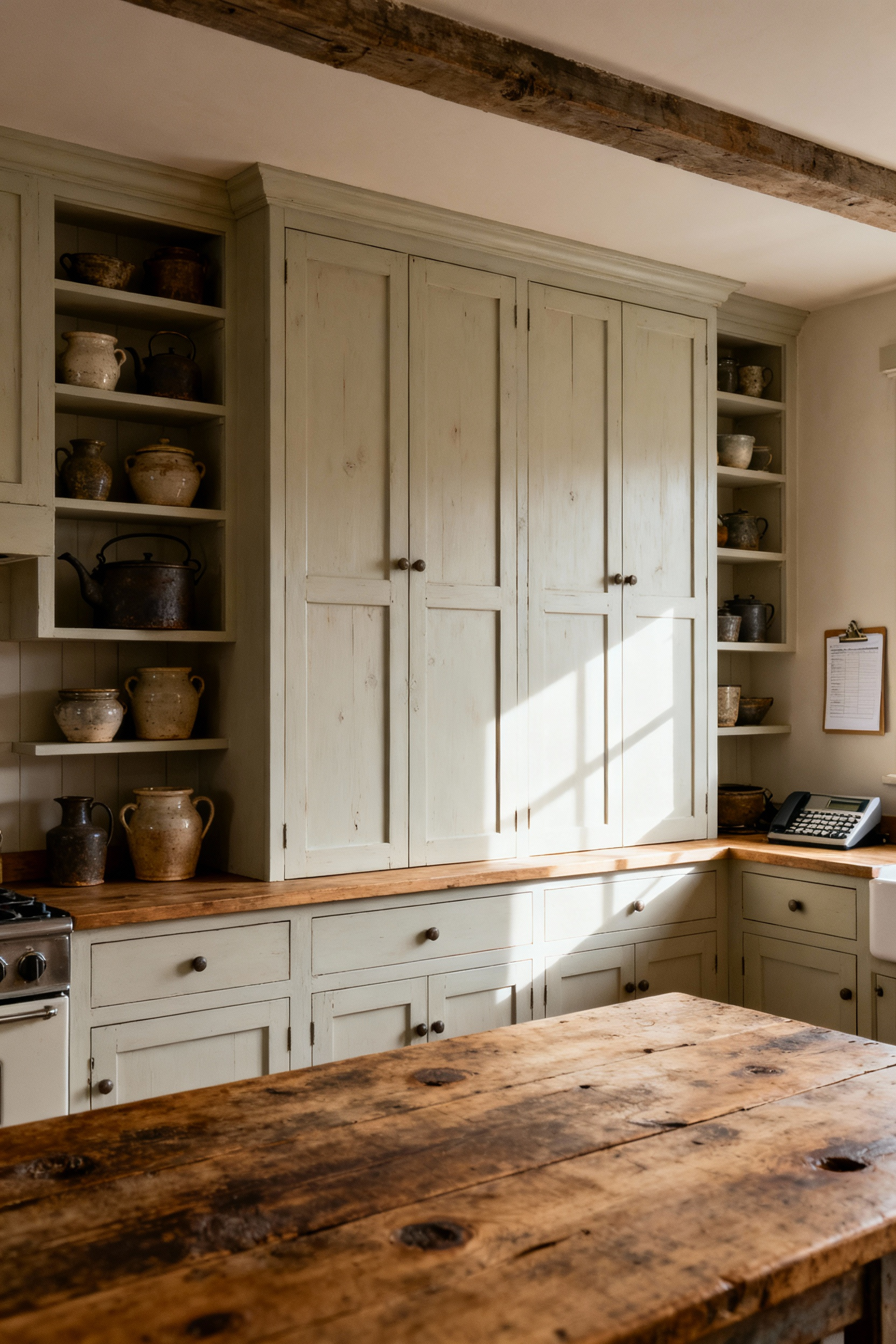
Every single element had a purpose. A thick countertop was for kneading bread and butchering meat, not just for show. Simple finishes were to protect the wood and be easy to repair. This is the crucial point: the beauty didn’t come from decoration, but from a rugged, pared-down utility. To truly get this right, you have to honor that source code of practical beauty.
2. Embracing Functional Simplicity as Design Dogma: Prioritizing Utility and Unadorned Beauty
Once you understand the practical origins, functional simplicity becomes a non-negotiable rule. It’s a deliberate design choice, a declaration that utility is beautiful. For farmhouse kitchen cabinets, this means clean lines, solid construction, and a resistance to clutter and fussy details. Think of the Shaker-style door—its elegance is in its perfect, unadorned proportions. There’s no molding that doesn’t also serve to strengthen the panel.
The beauty comes from the material itself—the warmth and grain of solid wood, the satisfying heft of a simple iron latch. In my historic home renovation practice, I always advise clients that the cabinet’s construction—the visible joinery, the thickness of the face frames—becomes the decoration. It’s an approach that celebrates integrity over embellishment, creating a space that feels calm, honest, and ready for work.
3. Cultivating Enduring Appeal Through Time-Honored Design Principles
The reason this style has lasted is because it was never a “style” to begin with. It was built on timeless principles, not fleeting trends. When you’re choosing or designing your farmhouse kitchen cabinets, you’re not thinking about what’s popular this year; you’re thinking about what will still look right in fifty years. Simple forms, natural materials, and classic proportions simply don’t go out of style.

They do something better: they acquire a patina. They collect the stories of a home and its family, growing more beautiful with every year of use. A kitchen designed this way is also inherently sustainable. Instead of participating in a cycle of gut renovations every decade, you’re investing in quality that is meant to last a lifetime. You’re crafting a permanent part of the home’s architecture.
4. Distinguishing Authenticity from Replication: The Essence of True Craftsmanship
This is where the rubber meets the road. In a world full of “farmhouse-style” knock-offs, telling the difference between authenticity and replication comes down to craftsmanship. An authentic cabinet tells a story of its making; a replica just mimics the look. True farmhouse kitchen cabinets are built from solid wood, not particleboard wrapped in a wood-look laminate. I’ve seen countless historic kitchens where the original cabinets are still perfectly functional after a century, while their modern, mass-produced counterparts fail in a decade.

Look for the details. Is the drawer box joined with strong dovetails, or just stapled together? Does the finish feel like it’s part of the wood, or is it a plastic-like coating sitting on top? Does it have the subtle imperfections of something made by a human hand? I learned this when I was restoring a 1790s Connecticut farmhouse—the original pantry cabinets had slight variations in the door stiles. Those weren’t mistakes; they were the signature of the person who built them. That’s the soul you’re looking for, and you can’t get it from a factory.
Ancestral Resonance and Authentic Imperatives (Part 2)
With the philosophy established, we can talk about the silent language of design: scale and proportion. Getting this right is less a science and more an art, but it’s what separates a room that feels ‘right’ from one that feels subtly off.
5. The Subtlety of Scale and Proportion: Orchestrating Visual Harmony in Rustic Spaces
More than any other element, getting the scale right is what gives a farmhouse kitchen its soul. This isn’t about strict mathematical rules; it’s about a feeling—an intuitive sense of balance and rightness that rural builders understood in their bones. Authentic farmhouse kitchen cabinets have a certain heft, a visual weight that grounds them in the room. They were built to last from solid timber, and they should look like it. The stiles and rails on the doors shouldn’t feel flimsy. Legs on a freestanding piece should feel substantial enough to do their job for a century.
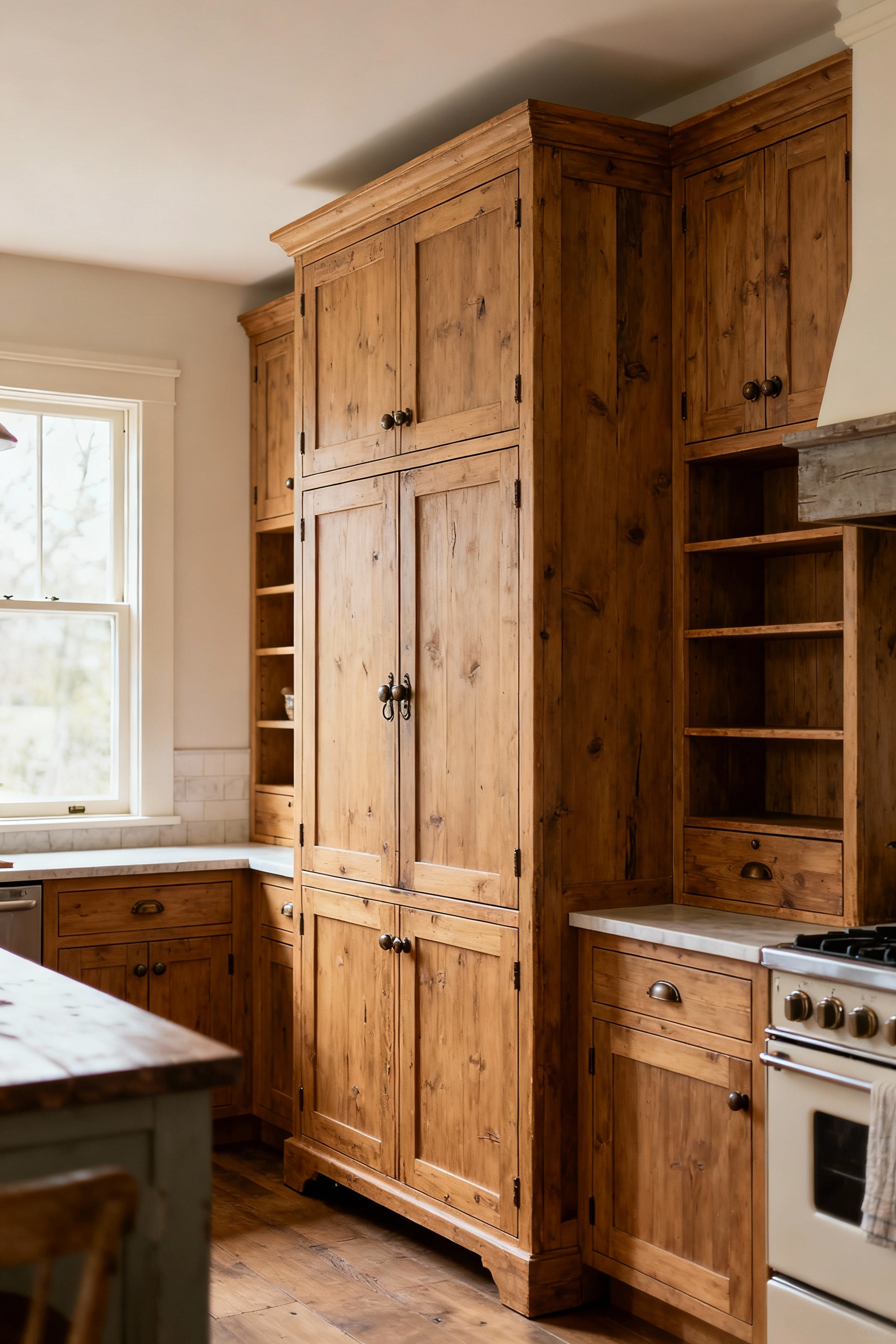
This is what’s so interesting—materials dictate the scale. A cabinet made from thick, reclaimed oak feels entirely different than one made from thin poplar. Hardware, too, plays a huge part. An undersized knob on a big, solid drawer front looks ridiculous; it feels weak. But a hefty, forged iron latch feels like a satisfying handshake. The goal is to create a dialogue between the different pieces in the room, making sure everything feels like it belongs together, creating a composition that is both strong and serene. It ensures the whole room feels anchored and permanent, like it has always been there.
Artisan Materials and Enduring Finishes (Part 1)
The soul of a farmhouse cabinet is in its bones—the wood it’s made from—and its skin—the finish that protects it. These choices aren’t just aesthetic; they are commitments to how the piece will age and endure over time.
6. The Unyielding Allure of Solid Wood Joinery: Honoring Traditional Construction Methods
The bedrock of any legacy piece of furniture is how it’s held together. For farmhouse kitchen cabinets, this means honoring traditional joinery. We’re talking about methods like the mortise and tenon, where two pieces of wood are interlocked like a puzzle, creating a bond that is stronger than the wood itself. Or the dovetail joint, visible on the side of a well-made drawer, whose interlocking pins make it impossible to pull apart. These techniques aren’t just for show; they are fundamental to building something that will last for generations.

Years of period-appropriate renovation taught me that modern shortcuts like staples and hot-glue are the enemies of longevity. When you choose cabinets built with solid joinery, you’re choosing furniture, not just boxes on a wall. It means the doors will hang true decades from now, and the drawers will glide open without racking. It’s an investment in structural honesty—a quality you can feel every time you open a door.
7. The Patina Palette: Curating Imperfection Through Thoughtful Finish Selections
A truly beautiful finish doesn’t fight against time; it collaborates with it. The idea of the “patina palette” is to choose finishes that will age gracefully, developing character with use. Think of it as curating imperfection. A thick, glossy polyurethane finish might look perfect on day one, but when it gets a deep scratch, it looks terrible and is nearly impossible to repair seamlessly. It’s a plastic shield.
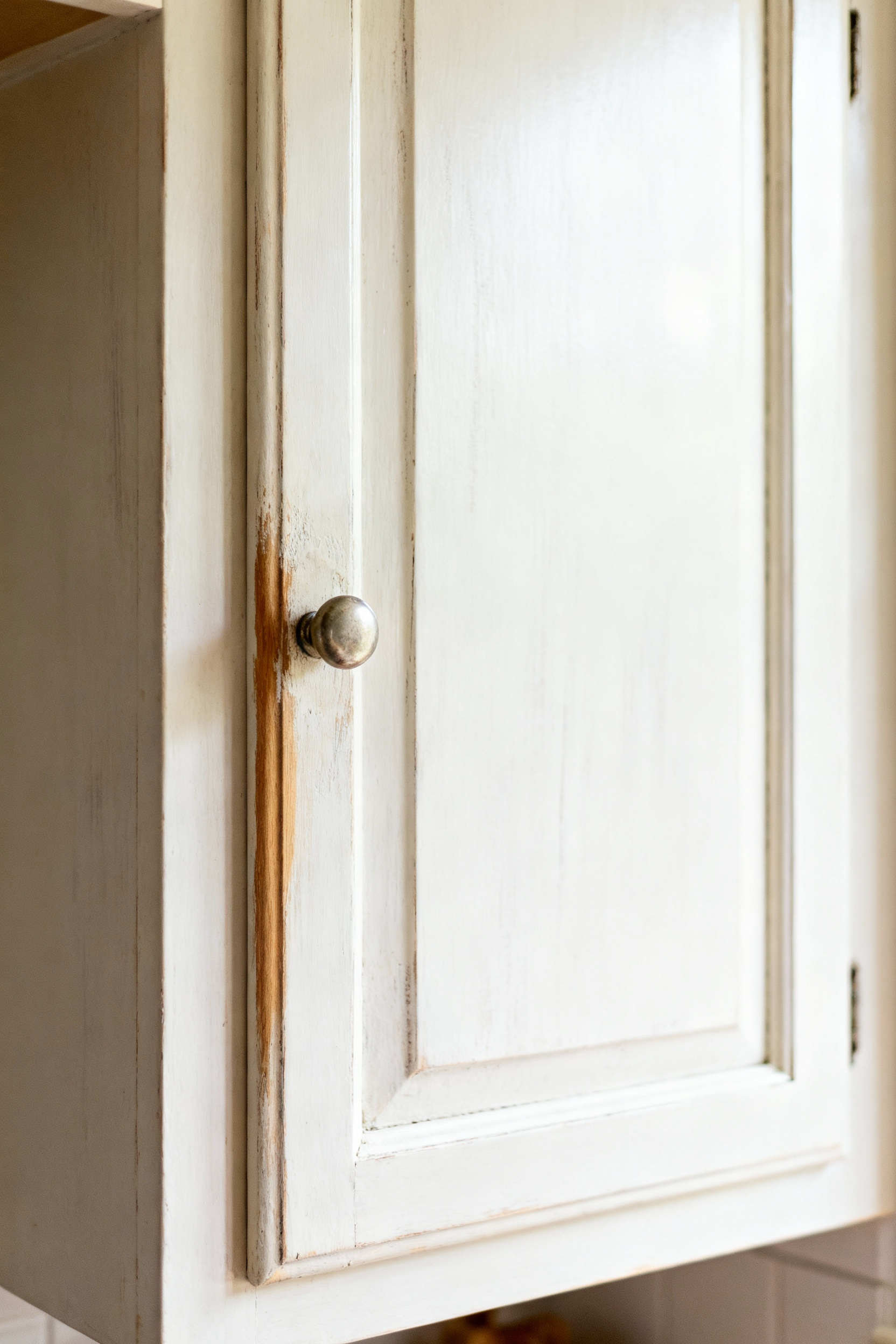
Instead, traditional finishes like milk paint or tung oil become part of the wood. Milk paint can develop a beautiful, slightly crackled surface and can wear away gently on the edges, revealing the wood beneath in a way that feels honest. An oil finish can be reapplied over the years, with each layer deepening the wood’s warmth and luster. The goal isn’t to keep the cabinets looking brand new. The goal is to allow them to tell the story of your home—a history written in tiny scuffs, worn spots, and the soft sheen from years of hands.
8. Distressed Detailing: Beyond Mere Artificial Antiquing, Embracing Organic Wear
Let’s be very clear about this: there’s a world of difference between thoughtful distressing and artificial antiquing. Smacking a new cabinet with a chain to make it look “old” is a theatrical trick, and it almost always looks fake. True distressing is about subtlety. It’s about recreating the organic wear patterns that happen over a century of life.
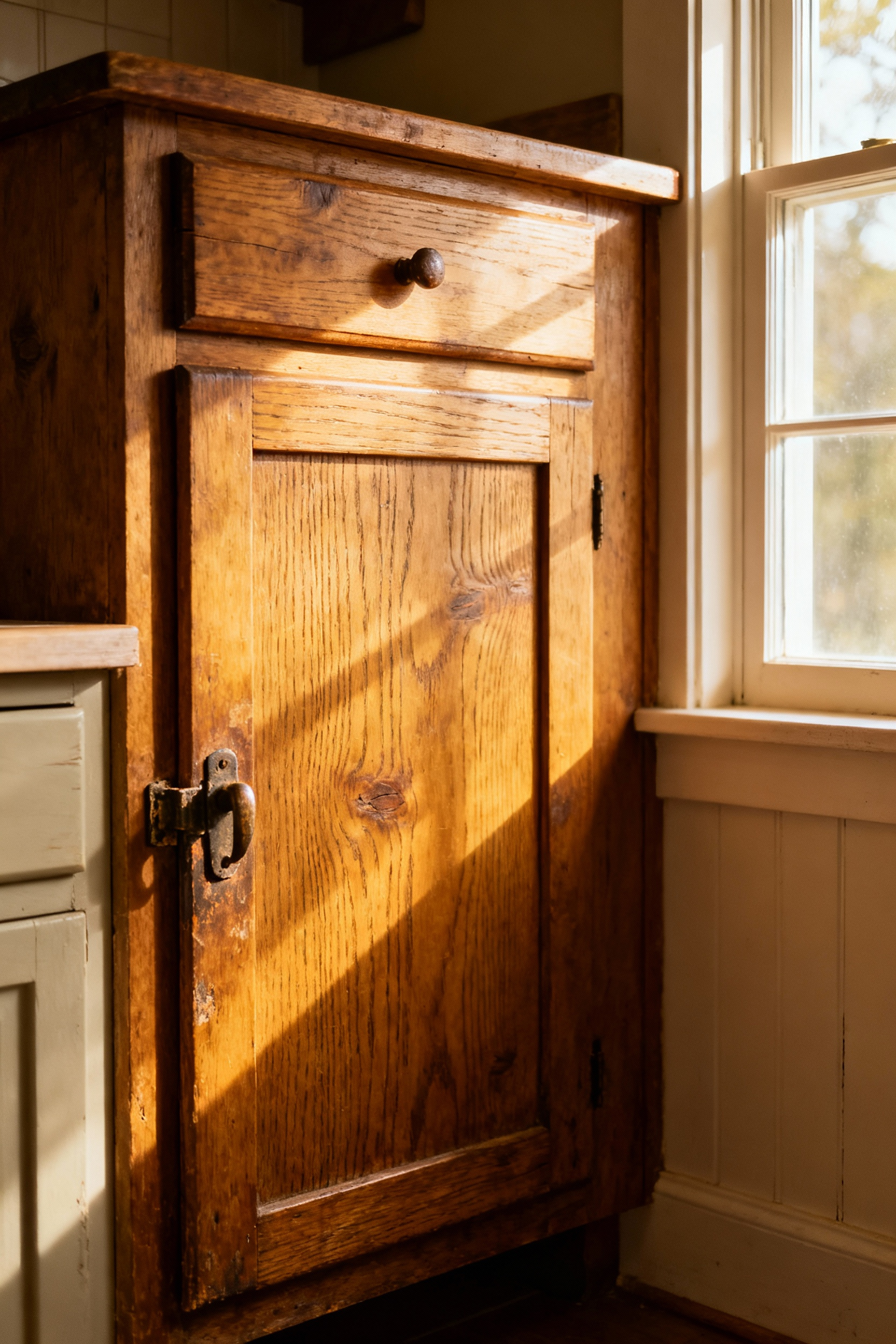
It’s the slight softening of a corner where people brush past it every day. It’s the almost imperceptible wearing away of paint around a drawer pull. In my practice, we achieve this by hand-sanding edges just enough to break the sharpness, or using layered paint techniques where a tiny bit of an undercoat might show through after gentle abrasion. It shouldn’t scream “I was made to look old!” It should whisper, “I have been here for a long, long time.”
9. Elevating Cabinetry with Thoughtfully Sourced Hardware: Anchoring Period Authenticity
Hardware is the jewelry of your cabinetry, but it’s also the primary point of physical contact. It needs to look right and feel right. Sourcing thoughtful, period-appropriate hardware is one of the most effective ways to anchor your design in authenticity. Skip the big-box stores and look for pieces made from honest materials: forged iron, solid brass, porcelain, or soapstone.

I particularly love using unlacquered brass. When installed, it’s bright and shiny, but over months and years, it mellows and deepens to a rich, warm brown, holding the oils from every hand that’s touched it. It ages in concert with the wood. The style matters, too. Simple latches, bin pulls, or exposed butterfly hinges do more than just open a door; they root the entire piece in a specific, tangible history. They provide that final layer of authenticity that makes the whole kitchen sing.
Artisan Materials and Enduring Finishes (Part 2)
A cabinet doesn’t exist in a vacuum. The surface it wears—the countertop—is its most important partner. This relationship is a dialogue of texture, color, and function that defines the character of the entire kitchen.
10. Counterpoint Craftsmanship: Harmonizing Work Surfaces with Cabinetry Aesthetics
The choice of a countertop is as critical as the cabinetry itself; it’s a decision that defines the kitchen’s voice. The best designs create a beautiful ‘counterpoint’ where the work surfaces and the farmhouse kitchen cabinets are in conversation with each other. Sometimes it’s a quiet, harmonious conversation; sometimes it’s one of dynamic contrast. The goal is a cohesive story.

I love pairing painted cabinets with the warmth of a butcher block countertop. A thick slab of maple or walnut introduces an organic, hardworking element that feels instantly welcoming and historically right. It will gather nicks and stains, and that’s the point—it’s a working surface meant to record a life of cooking. For a different kind of dialogue, soapstone is a fantastic choice. It’s a historic material that darkens with age and use, providing a cool, dark anchor against the warmth of natural wood farmhouse kitchen cabinets. What I tell my clients is to think about texture and feel. A honed, matte finish on stone feels much more at home in a farmhouse kitchen than a highly polished, reflective one. It’s about choosing materials that feel as honest as the cabinetry they sit on.
Harmonizing Form, Function, and Footprint (Part 1)
An authentic farmhouse kitchen feels effortless, but that ease is the result of meticulous planning. It’s a careful synthesis of historical forms and modern needs, where the layout, appliances, and lighting all work together in perfect harmony.
11. Orchestrating the Functional Flow: Strategic Layouts for Efficiency and Grandeur
The soul of a farmhouse kitchen is its workflow. This is the hearth of the home, a place of production and gathering, and its layout must support that. The old idea of a rigid “work triangle” is a bit outdated for how we live now. I prefer to think in terms of “work zones”—a dedicated area for prep, one for cooking, one for cleanup, and one for storage. A big, central island often becomes the heart of these zones, a landing pad for groceries, a surface for chopping, and a place for friends to lean with a glass of wine.
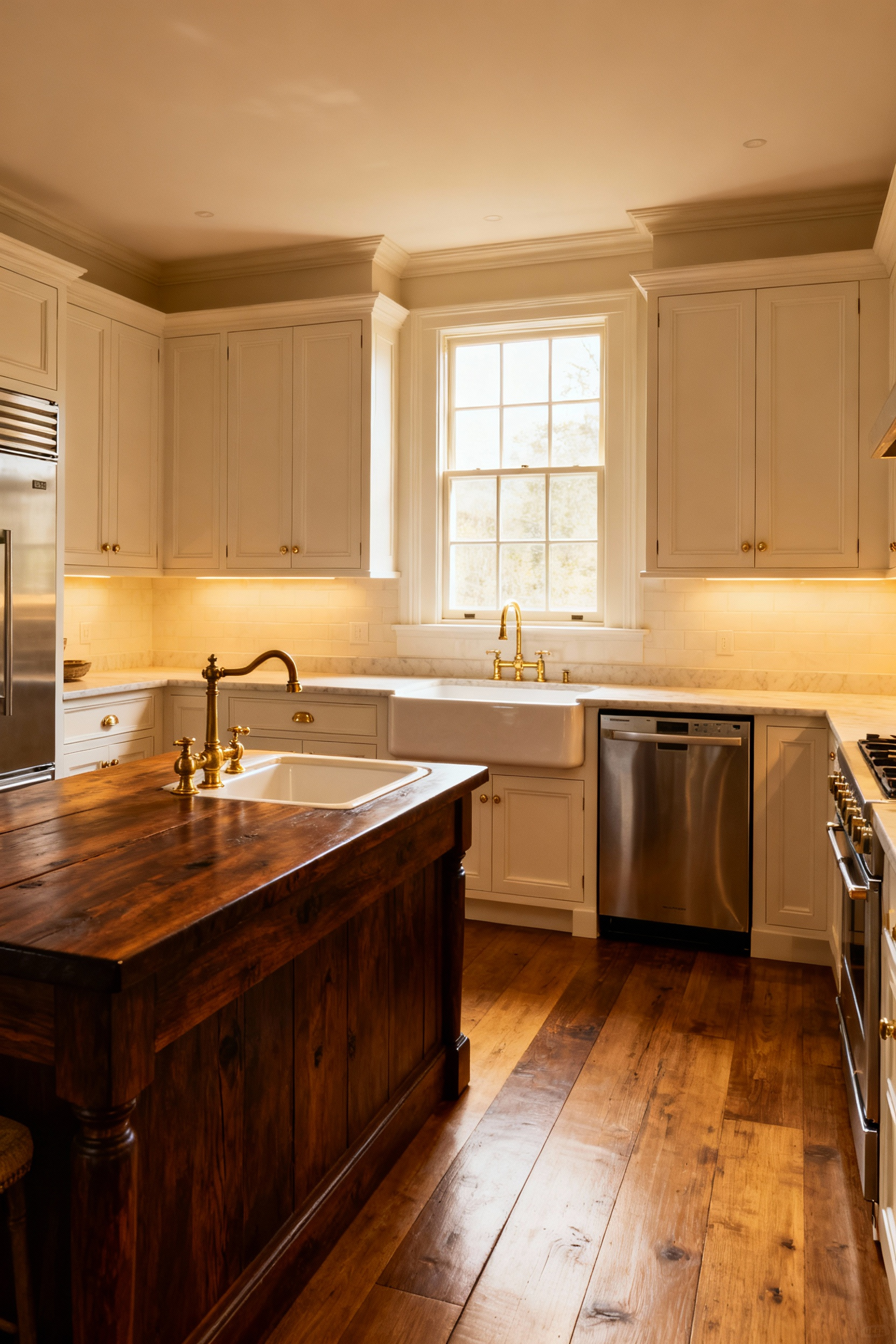
The surrounding farmhouse kitchen cabinets are the architecture that supports this flow. You want long, clear runs of countertop for big projects. You want the pantry near the prep zone. Grandeur in a farmhouse kitchen doesn’t come from soaring ceilings or fancy details. It comes from a sense of generous, uncluttered space and an intuitive layout that makes cooking and living feel easy and natural. The design should get out of the way and let life happen.
12. Bespoke Integration: Tailoring Cabinets for Period-Appropriate Appliances
Here’s the central challenge of my work: How do we live with modern technology in a historically sensitive space? The answer is bespoke integration. Your appliances are essential tools, but they shouldn’t be the visual focus. The artistry is in making them disappear. In a true farmhouse kitchen, the appliances serve the design; the design doesn’t bow to the appliances.
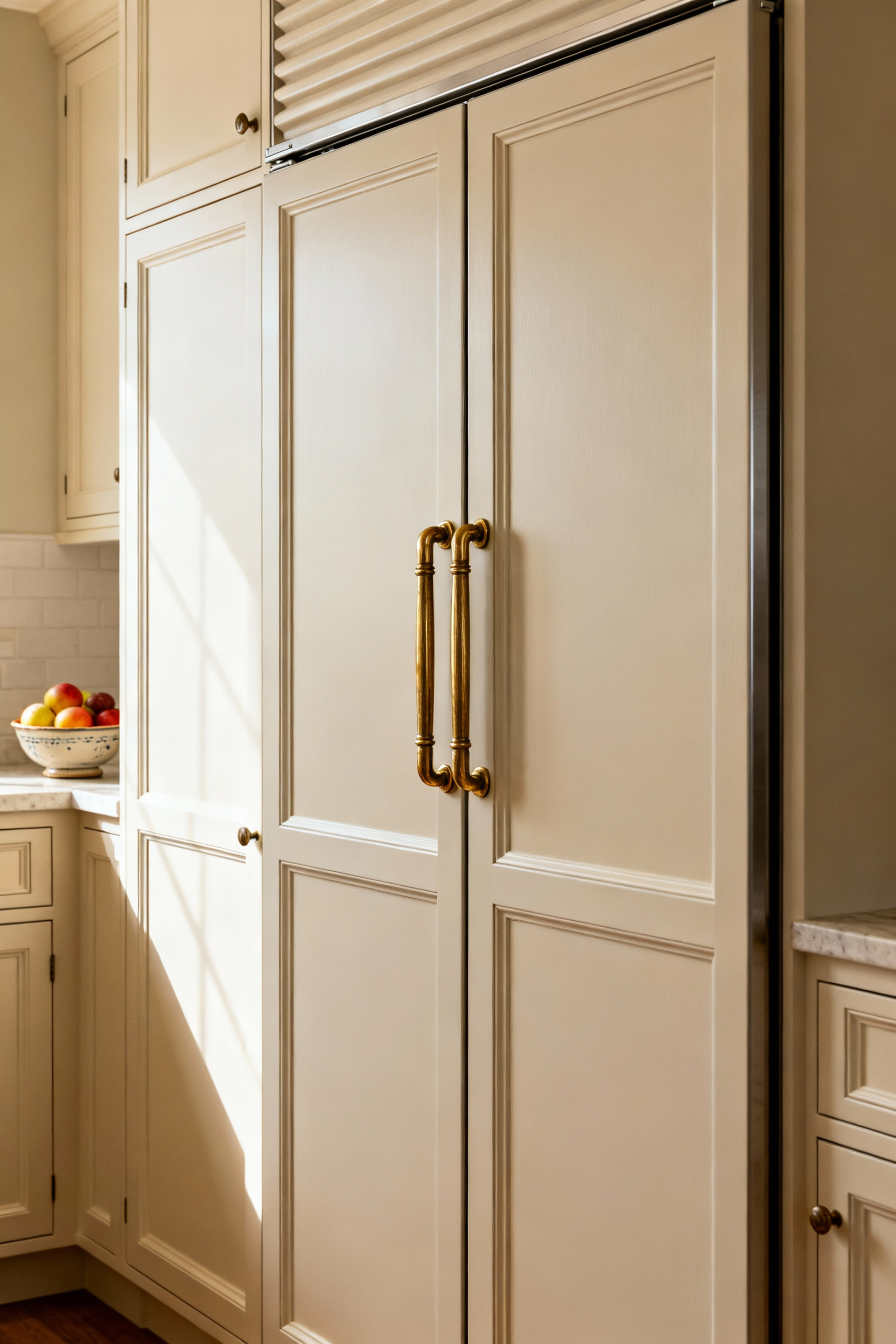
This means using custom cabinet panels to conceal the refrigerator and dishwasher so they blend seamlessly with the surrounding farmhouse kitchen cabinets. It means hiding the microwave in a pantry or an appliance garage. A powerful ventilation hood can be cleverly hidden within a custom-built chimney-style surround that looks like a part of the original architecture. It’s a game of hide-and-seek, where the goal is to let the beauty of the cabinetry and the historic character of the room take center stage.
13. The Illuminative Imperative: Highlighting Cabinetry with Artisanal Fixtures and Natural Light
Light is a building material. How you use it will shape the entire mood and function of your kitchen. The first priority in any farmhouse design should be maximizing natural light—it connects the home to the rhythms of the day and reveals the true texture and color of your materials. Let it pour in.

Then, you layer in artificial light. Fixtures should feel like they belong. Think of simple, hand-blown glass pendants, classic schoolhouse lights, or reproduction sconces with a warm, aged brass finish. Under-cabinet lighting is a modern necessity for task lighting, but it should be discreet. The light itself should feel warm and inviting, not harsh and sterile. Good lighting highlights the craftsmanship of the farmhouse kitchen cabinets, catching the subtle brushstrokes in the paint or the warm glow of aged wood.
14. Concealed Convenience: Designing Integrated Storage Solutions for a Clutter-Free Aesthetic
A farmhouse kitchen should feel serene and orderly, even when it’s the busiest room in the house. That feeling comes from one thing: excellent, concealed storage. The principle of ‘a place for everything, and everything in its place’ is paramount. Your farmhouse kitchen cabinets must be more than just beautiful doors; they have to be hardworking systems on the inside.
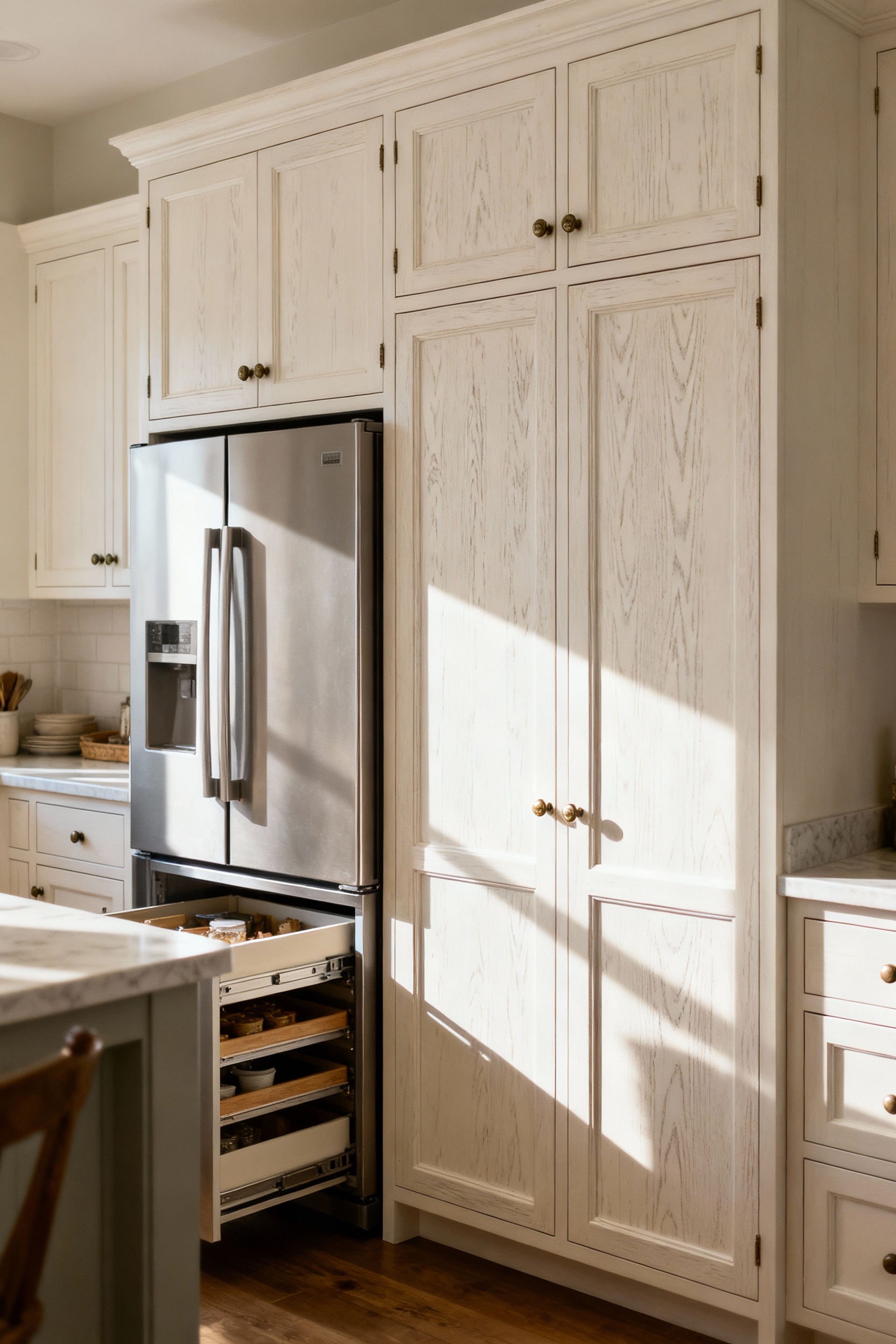
This means designing integrated solutions: pull-out pantry shelves that bring everything into view, drawer dividers for utensils and spices, a deep drawer with pegs to organize pots and pans, and concealed pull-out bins for trash and recycling. An appliance garage with a lift-up door can hide the toaster and coffee maker, keeping countertops gloriously clear. These aren’t just modern conveniences; they are the key to maintaining the simple, uncluttered aesthetic that is the hallmark of the farmhouse style.
Harmonizing Form, Function, and Footprint (Part 2)
Now we look up. The vertical space in a kitchen is an often-overlooked opportunity to add architectural character and immense functionality. How you handle the upper reaches of the room can turn a standard kitchen into something truly special.
15. Optimizing Verticality: Strategic Use of Stacking and Staggered Elements for Visual Interest
Most modern kitchens have a single, monotonous line of upper cabinets. A more authentic, historical approach is to think vertically, creating varied heights and depths that add architectural interest. Historically, kitchens were furnished with standalone pieces—hutches, cupboards, and larders—and we can recreate that feeling with built-ins. Stacking smaller, often glass-fronted, cabinets on top of your standard upper cabinets creates the elegant look of a floor-to-ceiling hutch. It’s a perfect place to store less-frequently used serving pieces or display treasured china.

You can also stagger the heights and depths of cabinets to break up a long wall. Perhaps a section of upper cabinets is deeper to create a baking station below, or a tall, narrow pantry cabinet punctuates a run of standard uppers. Using open shelving as a “pause” between cabinets is another great way to add visual texture. These moves make your farmhouse kitchen cabinets feel less like a system installed on the wall and more like an integrated, thoughtful part of the room’s architecture. It gives the whole space a custom, collected-over-time feeling.
Cultivating Character and Generational Legacy (Part 1)
A kitchen shouldn’t be a disposable set. When designed and built correctly, it should be an heirloom—a part of the house that gets better with age and is passed down with pride. This requires a commitment to materials and methods that are built for the long haul.
16. Ensuring Intergenerational Resilience Through Robust Construction and Material Selection
The single most important principle for creating a generational kitchen is building it to last. This is a philosophical choice as much as a practical one; it’s a quiet rebellion against a throwaway culture. For farmhouse kitchen cabinets, this starts with the right materials—solid hardwoods like maple, cherry, or quartersawn oak that are stable and strong. It means using time-tested joinery like mortise-and-tenon and dovetails.
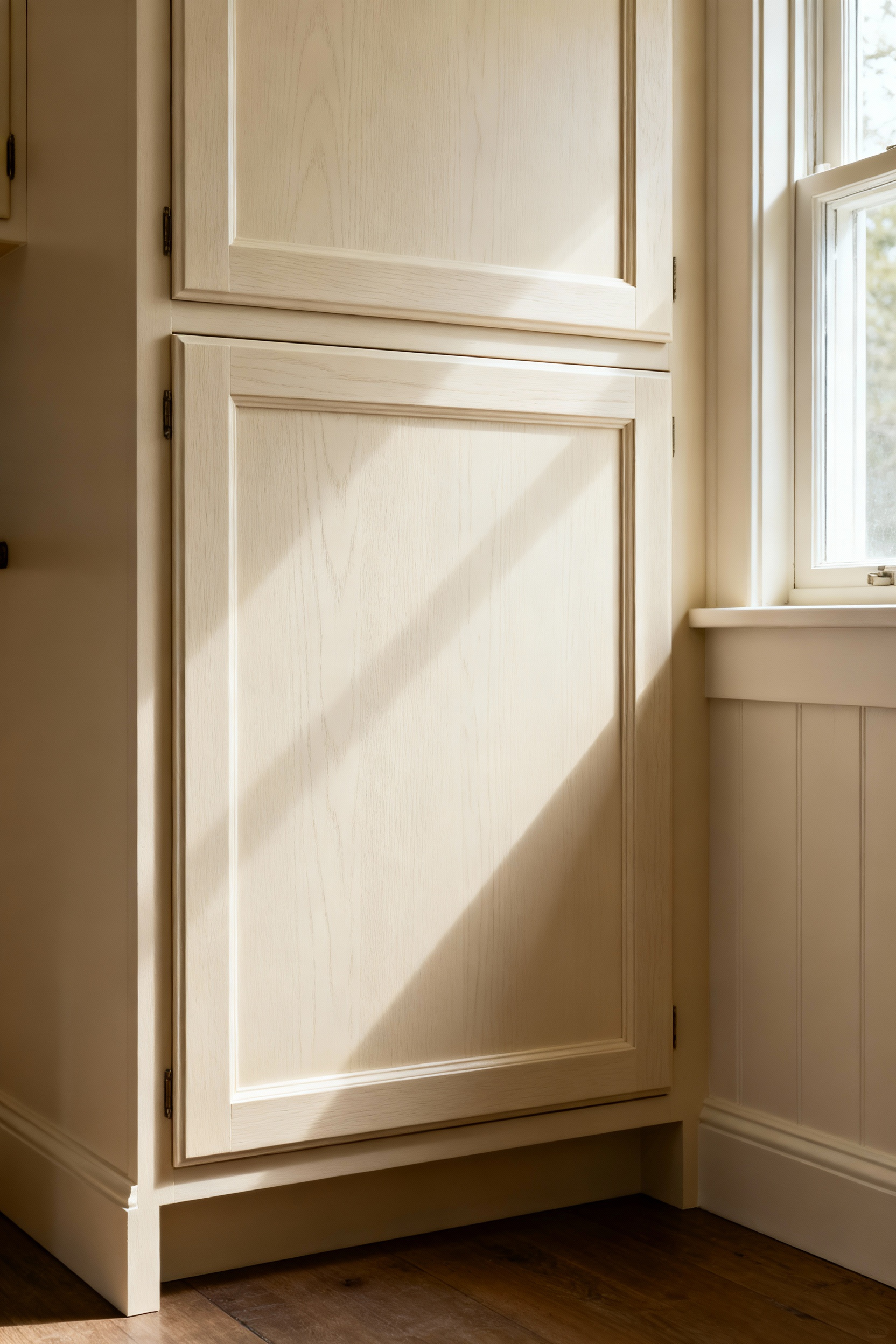
The construction should feel solid. The doors shouldn’t feel light or hollow. The drawers shouldn’t wobble. This robustness isn’t just about surviving daily use; it’s about creating a tangible sense of permanence. When you invest in this level of quality, you are crafting future antiques. You are building something with the integrity to not just serve your family, but the family that will live in your home fifty or a hundred years from now.
17. Anticipating and Embracing the Natural Evolution of Patina: A Mark of Enduring Use
Perfection is static and, honestly, a little boring. True character comes from life. Patina is the story of that life written on a surface. It’s the visual evidence of every meal prepared, every hand that opened a drawer, every spill that was wiped away. Far from being a flaw, it’s something to be welcomed and cherished.

To get this right, you have to choose materials designed to age well. Unlacquered brass hardware will tarnish. Soapstone countertops will darken and scratch. A waxed wood surface will develop a soft luster in the places it’s touched most often. A client of mine was worried about the first few dings on her new walnut island top, but a year later, she told me she loved how those little marks had blended into a warm, lived-in texture. She had learned to see it not as damage, but as the soul of her kitchen emerging.
18. Preserving Authenticity: Implementing Responsible Maintenance Practices for Longevity
Caring for well-made cabinets is an act of stewardship. It’s not about fighting to keep them looking new; it’s about preserving their integrity so they can continue to age gracefully. This means gentle, consistent care. For wood cabinets, dusting and cleaning with a soft, damp cloth is usually enough. Periodically, you can nourish the wood with a quality furniture wax or oil to keep it from drying out.
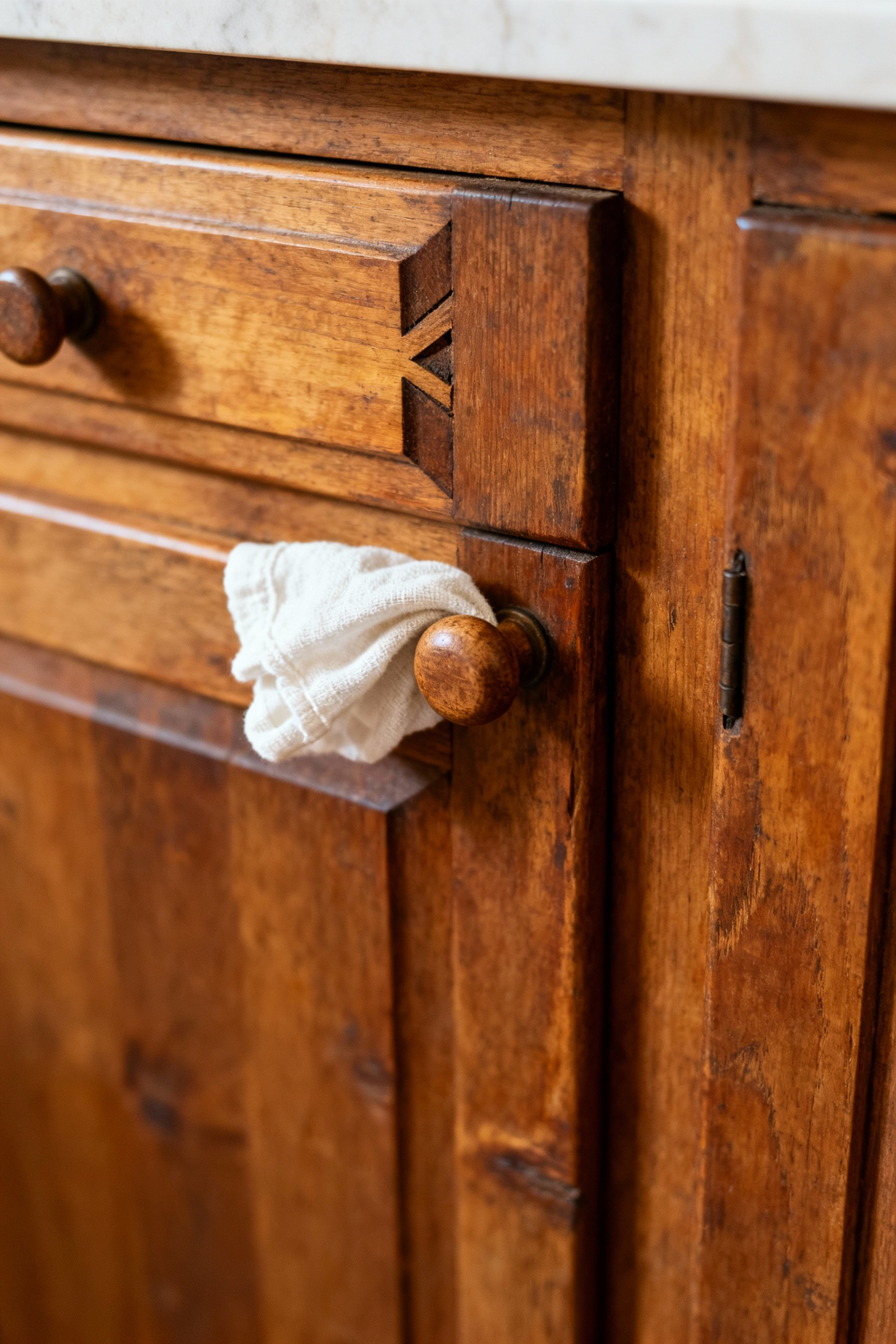
Avoid harsh chemical cleaners at all costs—they strip natural finishes and can create a bigger problem than the one you were trying to solve. Tighten hinge screws occasionally. Address spills promptly. This kind of mindful maintenance fosters a deeper connection to your home. It’s a rewarding ritual that honors the craftsmanship and ensures your investment will serve your family for a very long time.
19. The Evolving Narrative: Thoughtfully Adapting Farmhouse Design to Modern Living without Compromise
True historic preservation isn’t about freezing a house in time; it’s about allowing it to live and breathe in the present. The narrative of farmhouse design is always evolving. Our job is to adapt it for modern living thoughtfully, without sacrificing its soul. This means integrating soft-close drawer glides that you feel but don’t see, or hiding a charging station for devices inside a cabinet drawer.

You can honor the past while fully embracing the present. The key is to make modern function discreet. I’ve seen projects where a beautiful, period-perfect kitchen includes everything from a built-in espresso machine to an induction cooktop, all so skillfully integrated that the historic feeling of the room is never compromised. It’s the ultimate success: a kitchen that feels a hundred years old but works like it was built yesterday.
Cultivating Character and Generational Legacy (Part 2)
Ultimately, great design is about creating a legacy. It’s about crafting a space with a story so strong that it becomes part of the family, a timeless backdrop for the memories that will be made there for years to come.
20. Crafting a Timeless Testament: Leaving an Enduring Design Imprint for Future Generations
A home is more than a building; it’s a vessel for memories. When you design a kitchen, you have the opportunity to craft a timeless testament, a physical part of the home that will anchor the lives of future generations. That is the true power of getting farmhouse kitchen cabinets right. By focusing on authentic materials, honest craftsmanship, and timeless forms, you’re doing more than just a renovation—you’re contributing to the history of the house.
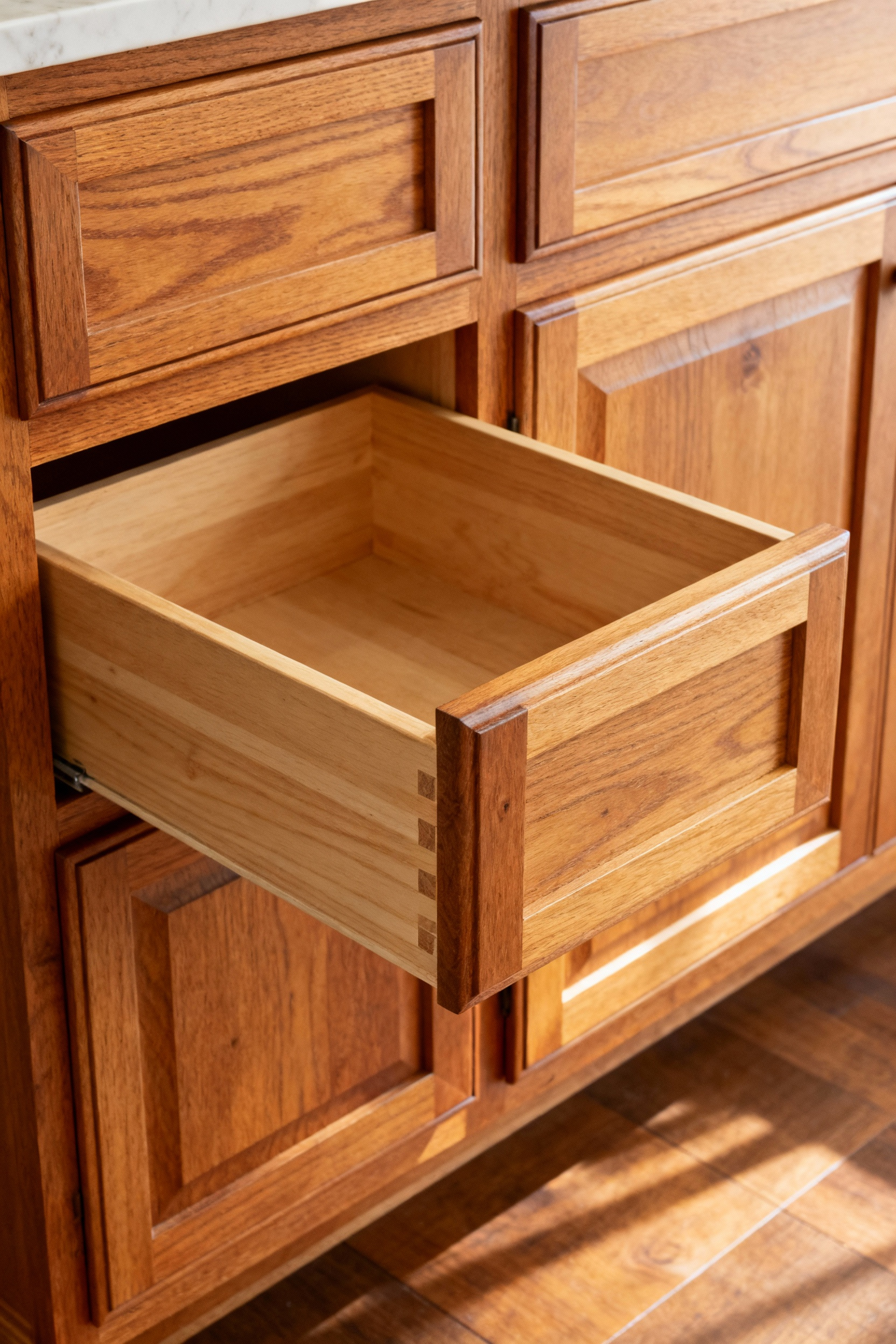
You’re choosing solid oak not just for its durability, but for the way it will absorb the sunlight and darken over fifty years. You’re choosing hand-forged hardware not just for its look, but for the way it will feel in your grandchild’s hand. The cabinets become silent witnesses to family history, their patina a map of countless gatherings and shared meals. This is the opposite of disposable design. It is an act of permanence, creating a legacy of quality and beauty that will enrich the home long after you’re gone.
Conclusion
As we’ve journeyed through these twenty principles, it’s become clear that creating truly enduring farmhouse kitchen cabinets is about so much more than a checklist of styles. It’s about understanding a philosophy rooted in utility, honesty, and a deep respect for materials. We’ve seen how this approach shapes everything, from the choice of wood and the method of joinery to the way a modern dishwasher can be seamlessly hidden from view. The goal is to create something with soul—a kitchen that feels like it has always belonged to the home.
The difference between a fashionable “farmhouse look” and an authentic farmhouse kitchen lies in this commitment to integrity. One is a temporary costume; the other is part of the home’s permanent architecture. It’s an approach that values the story of a hand-planed board and the quiet beauty of a perfectly executed dovetail joint. It’s about building things that are meant to be cherished, used, and passed down.
I hope these principles have given you the confidence and the vocabulary to pursue a kitchen that is not only beautiful but deeply meaningful. Use them as your guide to make choices that will stand the test of time. Create a space that doesn’t just serve your needs today but will become a treasured backdrop for the memories your family will create for decades to come. That is the real legacy of great design.






